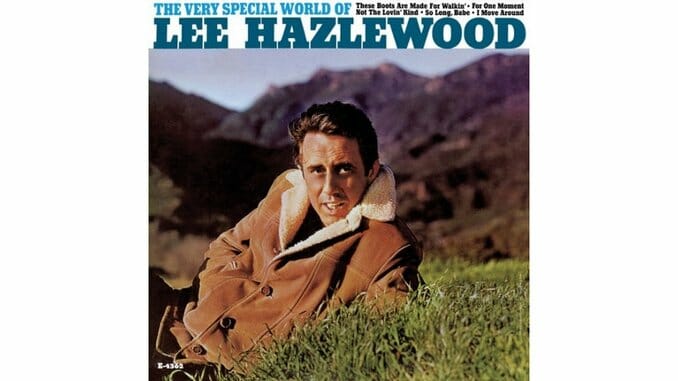Lee Hazlewood: The Very Special World of Lee Hazlewood/Lee Hazlewoodism – Its Cause and Cure/Something Special
Music Reviews
When Lee Hazlewood signed with MGM Records in 1965, he was feeling the full flush of his commercial powers. He had already scored hits with Duane Eddy, Dean Martin and country singer Sanford Clark. And within a few months, his collaboration with Nancy Sinatra on the infectious kiss-off “These Boots Are Made For Walkin’” would storm the pop charts around the world. He was also just a couple of years away from forming his own label, Lee Hazlewood Industries, where he would pour much of his creative energy for five years.
Why then jump in bed with another label for a three-album run of ornate and increasingly oddball pop music? As the liner notes, written by Tacoma-based musician/journalist Hunter Lea, that accompany the sumptuous reissues of those LPs—1966’s The Very Special World of Lee Hazlewood, 1967’s Lee Hazlewoodism – Its Cause And Cure, and 1968’s Something Special—reveal, it was an offer that few producers and songwriters at the time would turn down. It was, essentially, a blank check that allowed the then-37-year-old to, as his former girlfriend and muse Suzi Jane Hokom says in these notes, “do whatever he wanted…’Let’s have 20 violins, let’s have sessions that last forever. God, we’ve got all this money, we can spend all this money.’”
Nothing ever got quite that extreme, as the notes also spell out that Hazlewood and his chosen band (the studio musicians best known as the Wrecking Crew, augmented by string and horn players) would knock out a few songs a day. Nor do these fine albums feel excessive in any way. Unlike Hazlewood’s contemporary Phil Spector, a producer that likes to assault listeners with thick clouds of sound, the music throughout these MGM releases are suffused with open air and empty spaces; all the better to make you feel elated and calm.
The best of these albums, Something Special, happens to be the one with the most oxygen flowing through it. Outside of a string-heavy opening track, the other nine tunes were recorded with something of a skeleton crew—often, just three guitars, bass, drums and piano, playing Hazlewood’s jazz/blues-leaning, almost-novelty tunes. It’s also the record with the strangest sonic touch, which is the growling scat-singing of keyboardist Don Randi getting cranked in the mix during the instrumental passages. It was as if he was daring his benefactors at MGM to blink after bankrolling him this whole time. And blink they did, as this reissue is the first time Special is being officially issued in the U.S. In ‘68, the label only allowed its release in Germany and Scandinavia.
The oft-repeated comment in Lea’s notes is that these three albums were considered to be “expensive demos,” calling cards to let other performers hear these songs before they went to record them. While that was the case with a number of the tunes here (notably, Nancy’s dad Frank would record “This Town”—found on Special—for his ‘67 LP The World We Know), the rest often feel like Hazlewood trying to reckon with his place in the pop landscape.
The Very Special World was Hazlewood, in a way, acceding to what he thought was expected of him by his new label. It’s mostly stacked with tunes that he had already given away to other artists. On it is his version of “Boots” and many other songs that were recorded by Nancy Sinatra, as well as “Not The Lovin’ Kind,” which he gave to both her and the kitschy pop trio Dino, Desi & Billy. And throughout the album, you also hear Hazlewood playing to the charts a bit. “When A Fool Loves A Fool” is driven by a Herb Alpert-type horn section, and other songs are treated with an easy listening like approach: heavy on the strings and emotional bombast.
There was also a sense that Hazlewood was trying to prove how versatile his material is. The arrangement for “Sand” that landed on Nancy Sinatra’s 1966 LP How Does That Grab You? feels influenced by the Greenwich Village folk scene, whereas the recording here has much more bubble and swing. “Lovin’,” on the other hand, is treated on Very Special like something arranged by Antonio Carlos Jobim, not long after it was given some Byrds-ian jangle on the Dino, Desi & Billy album I’m A Fool and an austere rendition by Nancy.
Hazlewood’s follow up album on MGM cared very little for any commercial prospects. Hazlewoodism is a multifarious affair that finds the producer/songwriter dipping into his country/western past and playing a bit with the mood of the times. It all holds together somehow, solely on the magnetism of Hazlewood who can play the bemused hick looking at the hippies “smoking funny cigarettes” and taking “trips but never move” while also utilizing musical references to “Day Tripper” and “I”ll Feel A Whole Lot Better.” He also dared to reference himself with tracks like “Suzi Jane Is Back In Town,” a duet with Hokom that plays as a funhouse mirror version of his work with Nancy Sinatra, and “Jose” and “The Nights,” which hearken back to his earliest recordings.
What were likely viewed at the time by MGM as a tax write off and by Hazlewood as simply further efforts to expand his already vast domain in the pop music landscape can now be appreciated as fun curiosities nestled amid a discography full of oddities and playful genre exercises. That they don’t cohere into complete album statements is really beside the point. These three records continue to exist as artifacts of the mid-to-late ‘60s that are sneakily influencing the sound of a few daring contemporary songwriters. Listen closely and you’ll hear it.